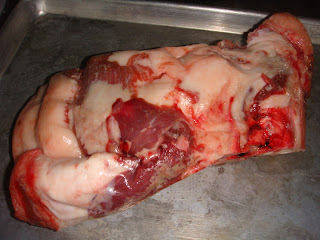I’ve mentioned locavore eating many times – consuming only what has been produced within 50 or 100 miles of where you live; there are many variations on the theme, depending on how enthusiastically you wish to embrace the challenge.
Further to that, you can now find nose-to-tail dinners in area restaurants. For recreational eaters, this is an exciting concept; for others about town, it’s quite old hat.
Over 50 years old? If so: cracklings, headcheese, liver pate, blood sausage, tripe, and pickled pig’s feet, are probably nothing new.
However, I’m in a holding pattern under the big five-o, and not so worldly-wise about preparing the unmentionable parts of animals.
It’s my business to keep a licked finger held skyward to pinpoint the direction of culinary shifts, so I felt the urge to establish a cookable-connection to underutilized animal parts.
No, not tongue, liver, or heart! No testicles, sweetbreads, cockscombs, ears, tails, or unlaid chicken eggs!
I barbecued half a pig head. It wasn’t easy; I don’t like to look anything I’m going to eat in the eye.
The eye had been removed by the processor (whew).
It was without skin, ears, brain, or jaw - but still had a snout, smile, and a wink, on the bone.
After four hours on the smoker, it appeared even more like an animal face, and I couldn’t look at it; I took it off the grill, wrapped it in foil, and put it in the refrigerator.
(Avoidance, it’s a legitimate coping mechanism.)
The following morning, I cooked it (covered) for another 7 1/2 hours. Some barbecue saucing action accentuated the piggy’s facial crinkles; then, it was over.
Delicious, porky, barbecue aroma filled the kitchen. Pull-apart tender morsels of cheek surrendered up a very rich smoky flavor, and yielded enough meat to make four sliders.
I counted it as an incredible experience that would have cost a pretty penny dining out.
However, I felt oddly about it, and was concerned that I had merely hitched a ride onto yet another passing foodie trend – and while delicious – it held little substance.
We produce our own milk, cheese, eggs, and meat. Farmer’s market has filled our freezer with tomatoes and peppers; the refrigerator teems with local mushrooms, berries, artichokes, and leeks.
Blessed with so much to eat, why indulge an exploration into the nasty bits?
It took me a while to realize that I already had the answer. There’s a morality involved in taking an animal’s life for food.
It’s all too easy to take a meat package out of the supermarket case and put it in the cart without thinking twice about where it came from, or the conditions under which it was raised and processed. This experience has served as a reminder not to waste what can be eaten, and one thing more.
All those people - with the foodie dinners and the eat-local challenges – I hope it can be more than just enjoying themselves in the moment - that it becomes an opportunity to consider farming and sustainability, and to reconcile themselves with their lifestyle choices. All meat has a face.


